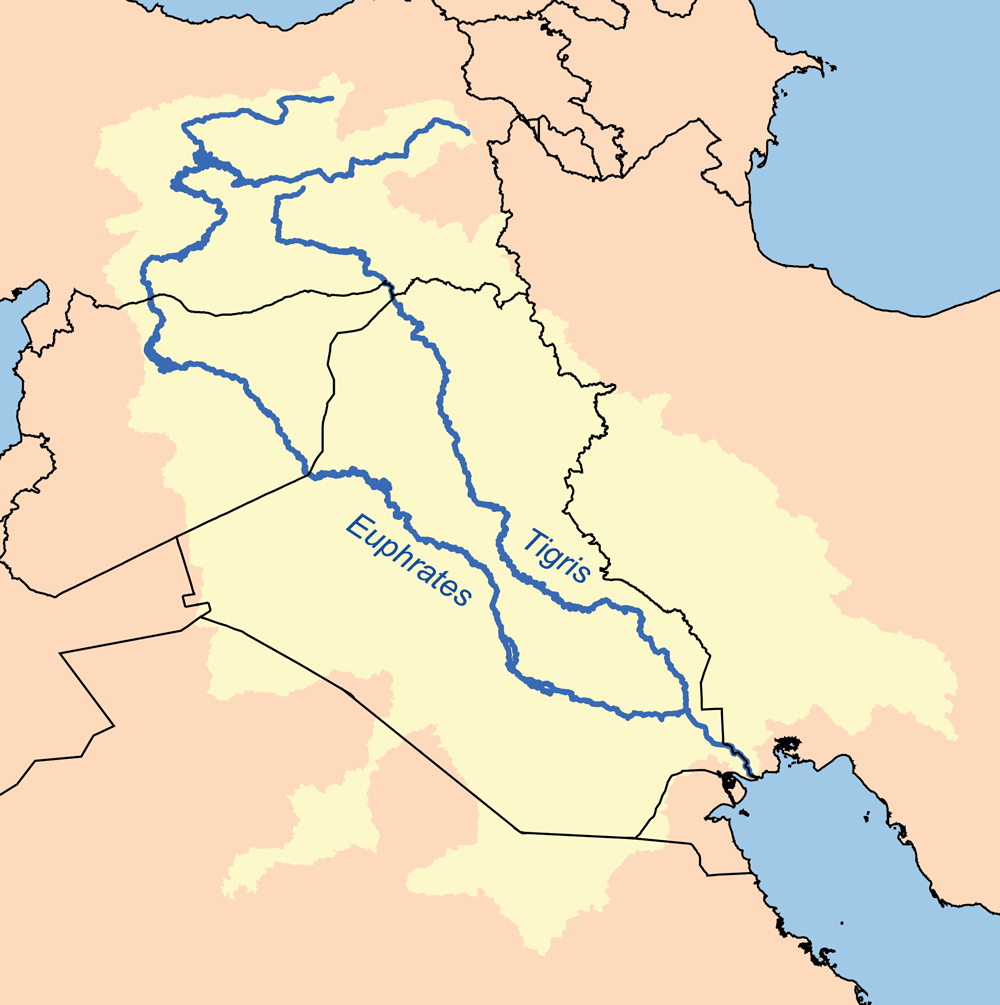
Tigris–Euphrates river system
The Tigris–Euphrates river system is a large river system in Western Asia that discharges into the Persian Gulf. Its principal rivers are the Tigris and Euphrates, along with smaller tributaries.
Tigris–Euphrates river system
From their sources and upper courses in the Armenian Highlands of eastern Turkey, the rivers descend through valleys and gorges to the uplands of Syria and northern Iraq and then to the alluvial plain of central Iraq. Other tributaries join the Tigris from sources in the Zagros Mountains to the east. The rivers flow in a south-easterly direction through the central plain and combine at Al-Qurnah to form the Shatt al-Arab and discharge into the Persian Gulf.[1] The rivers and their tributaries drain an area of 879,790 km2,[2] including almost the entire area of Iraq as well as portions of Turkey, Syria, Iran, and Kuwait.[3][4][5][6][7]
The region has historical importance as part of the Fertile Crescent region, where Mesopotamian civilization first emerged.
Geography[edit]
The Tigris–Euphrates Basin is shared between Turkey, Syria, Iraq, Iran, and Kuwait.[6][3][4][5][7] Many tributaries of the Tigris river originate in Iran, and the Shatt al-Arab, formed by the confluence of the Euphrates and Tigris rivers, makes up a portion of the Iran–Iraq border, with Kuwait's Bubiyan Island being part of its delta.[8][9] Since the 1960s and in the 1970s, when Turkey began the GAP project in earnest, water disputes have regularly occurred in addition to the associated dam's effects on the environment. In addition, Syrian and Iranian dam construction has also contributed to political tension within the basin, particularly during drought.
The ecoregion is characterized by two large rivers, the Tigris and Euphrates. The high mountains in the upper watershed receive more rain and snow than the lower watershed, which has a hot and arid subtropical climate. Annual snow melt from the mountains brings spring floods, and sustains permanent and seasonal marshes in the lowlands.
The plain between the two rivers is known as Mesopotamia. As part of the larger Fertile Crescent, it saw the earliest emergence of literate urban civilization in the Uruk period. For this reason, it is often described as a "Cradle of Civilization".
There is a large floodplain in the lower basin where the Euphrates, Tigris, and Karun rivers converge to create the Mesopotamian Marshes, which include permanent lakes, marshes, and riparian forests. The hydrology of these vast marshes is extremely important to the ecology of the entire upper Persian Gulf.
Water dispute[edit]
The issue of water rights became a point of contention for Iraq, Turkey and Syria beginning in the 1960s when Turkey implemented a public-works project (the GAP project) aimed at harvesting the water from the Tigris and Euphrates rivers through the construction of 22 dams, for irrigation and hydroelectric energy purposes. Although the water dispute between Turkey and Syria was more problematic, the GAP project was also perceived as a threat by Iraq. The tension between Turkey and Iraq about the issue was increased by the effect of Syria and Turkey's participation in the UN embargo against Iraq following the Gulf War. However, the issue had never become as significant as the water dispute between Turkey and Syria.[16]
The 2008 drought in Iraq sparked new negotiations between Iraq and Turkey over trans-boundary river flows. Although the drought affected Turkey, Syria and Iran as well, Iraq complained regularly about reduced water flows. Iraq particularly complained about the Euphrates River because of the large number of dams on the river. Turkey agreed to increase the flow several times, beyond its means in order to supply Iraq with extra water. Iraq has seen significant declines in water storage and crop yields because of the drought. To make matters worse, Iraq's water infrastructure has suffered from years of conflict and neglect.[17]
In 2008, Turkey, Iraq and Syria agreed to restart the Joint Trilateral Committee on water for the three nations for better water resources management. Turkey, Iraq and Syria signed a memorandum of understanding on September 3, 2009, in order to strengthen communication within the Tigris–Euphrates Basin and to develop joint water-flow-monitoring stations. On September 19, 2009, Turkey formally agreed to increase the flow of the Euphrates River to 450 to 500 m3/s, but only until October 20, 2009. In exchange, Iraq agreed to trade petroleum with Turkey and help curb Kurdish militant activity in their border region. One of Turkey's last large GAP dams on the Tigris – the Ilisu Dam – is strongly opposed by Iraq and is the source of political strife.[18]